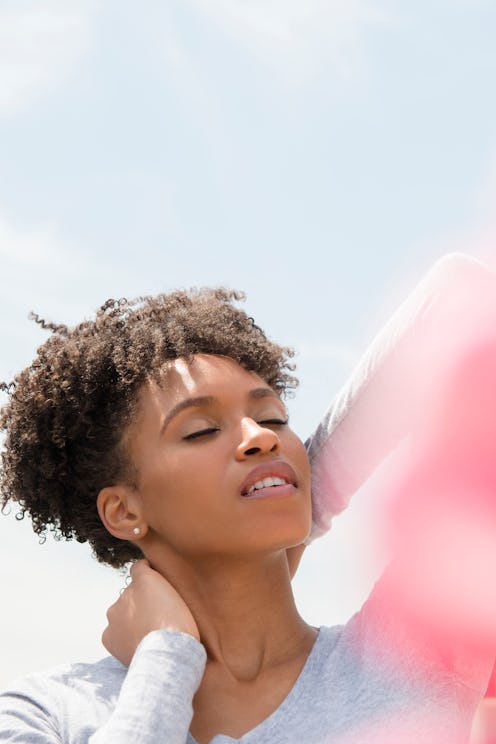Wellness
7 Self-Massage Tips, Straight From TikTok
Including one for when your stomach’s out of sorts.

There are lots of time in life where a professional massage seems like heaven. But if you can’t get to a massage therapist, TikTok’s got you covered, with a host of self-massage techniques to soothe your aching muscles.
Even if you’re not trained as a masseuse, self-massage can help your muscle aches and increase blood flow — and you don’t have to invest in a lot of fancy equipment to do it. Though if you’re really longing to pick up that indulgent jade roller to relax your face, go on, treat yo’self). As the massage therapists and chiropractors of TikTok show, with a bit of practice and some spare time, you can work out those kinks and feel better after a long, hard day.
The #selfmassage TikTok tag is part of a wider TikTok trend for at-home wellness advice. From at-home yoga tutorials to guides on meditation, TikTokers have been showing their expertise in all-things self-care. The platform even has a Wellness Hub to collect the most popular resources in one place. Self-massage videos, in particular, demonstrate easy techniques for getting a knot out of your neck, or foam rolling after a hard workout.
So light a candle, get your favorite oil, and learn how to give yourself a massage with some of TikTok’s best tips.
Gas-Fighting Massages
Self-massage around the abdomen is a well-known therapy for constipation, according to the National Health Service. Got gas or feeling a bit blocked up? This TikTok from wellness practitioner Anne Swanson shows how to apply pressure on different areas of your tum to relieve gas build up.
Lower Back Bends
Stretching regularly can help with chronic lower back pain, according to a 2016 review published in Healthcare. Feeling like you need to hang a bit loose? This TikTok from massage therapist James Moore shows how to pick up a pillow, place it on the side of a bed or sofa, and stretch your back downwards to loosen things up.
Foot Massages
Regular foot massage can improve your foot circulation and reduce your stress levels, per Harvard Health. If you’re feeling tense, this guide from Kosha Spa shows how to do circular movements around your soles and the pads of your feet.
Foam Roller Leg Massages
A study published in Frontiers in Physiology in 2020 found that foam rolling on muscles is as effective as traditional muscle massage for decreasing pain, helping recovery, and increasing flexibility. This TikTok from massage therapist Becca Walker shows some ideas for loosening muscles with your roller at home.
Neck Massages
A 2020 study published in Scientific Reports found that 10 minutes of gentle massage, even just stroking the back of your neck, can help lower stress levels. Acupuncturist Laurel Liu takes you through some soothing neck massage movements in this TikTok.
Shoulder Tension Massages
A lot of neck and shoulder aches are caused by leaning over laptops, per a study published in Journal of Physical Therapy Science in 2018. (Cough, work from home, cough.) Chiropractor Daniel DeLucchi’s guide to loosing your shoulder tension just needs a wall and a tennis ball or softball.
TMJ Massages
The temporomandibular joint, or TMJ, is what connects your jaw bone to your skull, and when it hurts, it hurts; a study in 2013 published in Journal Of Pain found that people with depression and anxiety were more likely to experience TMJ pain, likely because stress causes jaw clenching. This tip from Becca Walker involves soft, gentle upward movements to the underside of your cheekbones to help relieve TMJ pain.
Studies cited:
Franklin, N. C., Ali, M. M., Robinson, A. T., Norkeviciute, E., & Phillips, S. A. (2014). Massage therapy restores peripheral vascular function after exertion. Archives of physical medicine and rehabilitation, 95(6), 1127–1134. https://doi.org/10.1016/j.apmr.2014.02.007
Gordon, R., & Bloxham, S. (2016). A Systematic Review of the Effects of Exercise and Physical Activity on Non-Specific Chronic Low Back Pain. Healthcare (Basel, Switzerland), 4(2), 22. https://doi.org/10.3390/healthcare4020022
Kindler, S., Samietz, S., Houshmand, M., Grabe, H. J., Bernhardt, O., Biffar, R., Kocher, T., Meyer, G., Völzke, H., Metelmann, H. R., & Schwahn, C. (2012). Depressive and anxiety symptoms as risk factors for temporomandibular joint pain: a prospective cohort study in the general population. The journal of pain, 13(12), 1188–1197. https://doi.org/10.1016/j.jpain.2012.09.004
Kerautret, Y., Di Rienzo, F., Eyssautier, C., & Guillot, A. (2020). Selective Effects of Manual Massage and Foam Rolling on Perceived Recovery and Performance: Current Knowledge and Future Directions Toward Robotic Massages. Frontiers in physiology, 11, 598898. https://doi.org/10.3389/fphys.2020.598898
Lee, S. P., Hsu, Y. T., Bair, B., Toberman, M., & Chien, L. C. (2018). Gender and posture are significant risk factors to musculoskeletal symptoms during touchscreen tablet computer use. Journal of physical therapy science, 30(6), 855–861. https://doi.org/10.1589/jpts.30.855
Miyaji, A., Sugimori, K., Hayashi, N. (2018) Short- and long-term effects of using a facial massage roller on facial skin blood flow and vascular reactivity. Complementary Therapies in Medicine, 2018; 41: 271 DOI: 10.1016/j.ctim.2018.09.009
Meier, M., Unternaehrer, E., Dimitroff, S.J. et al. (2020) Standardized massage interventions as protocols for the induction of psychophysiological relaxation in the laboratory: a block randomized, controlled trial. Sci Rep10, 14774. https://doi.org/10.1038/s41598-020-71173-w
This article was originally published on